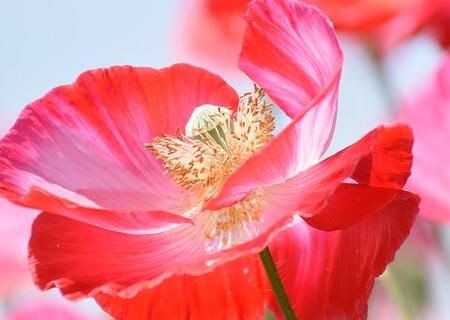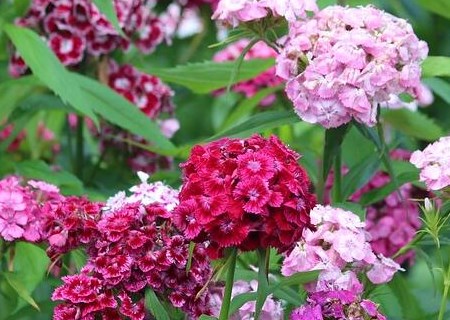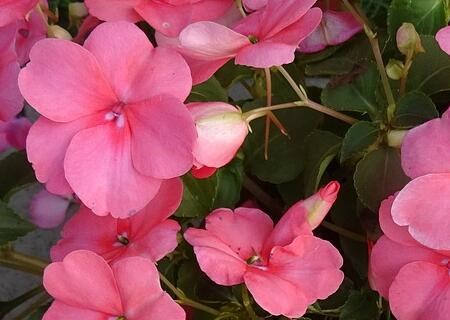What are the seed planting methods of annual herb Yumeiren? What's the difference between poppy and poppy? What's the price?
Yumeiren, an annual herb, is used as a medicine for flowers and whole plants, which contains a variety of alkaloids and has antitussive, antidiarrheal, analgesic and sedative effects. As an ornamental plant, it is commonly cultivated in all parts of China. So do you know what are the seed planting methods of Yu Mei? What's the difference between poppy and poppy? What's the value?

Seed planting method of Yumei
1. Methods of reproduction
Yumei is mainly propagated by sowing and is usually cultivated for 2 years. Yumei flowers and plants of the same genus are taproot, few fibrous roots, and are not resistant to transplant, so direct seeding is applied. If it is needed for garden layout, it is best to use a nutrition bowl or small paper basin to raise seedlings, even a bowl or pot transplant, otherwise it is difficult to survive or grow poorly. The sowing date is determined according to the climatic characteristics, and the northeast region is relatively cold, which can sprout as early as possible in spring. Small seeds, fine sowing, using strip sowing, row spacing of 25-30 cm, cover the surface with hay to protect against cold in severe winter. The suitable temperature for seed germination is 20 ℃. Families can broadcast live in flowerpots.
Sow and reproduce. It can be sown in spring and autumn, generally speaking, spring sowing is from March to April, florescence is from June to July, autumn sowing is from September to November, and florescence is from May to June of the following year. In order to collect seeds, it is best to sow in autumn. The soil should be cleaned up fine, make the bed watered, and then sow or strip sow. Because the seeds of Yu Mei are small, when sowing, the soil should be leveled and beaten finely. After sowing, there is no need to cover the soil, but it can also be covered with a thin layer of fine sand. The thickness of the covered soil should not be seen (0.2-0.3 cm). In North China, because of the severe cold in winter, it is difficult for seedlings to survive the winter, so the direct seeding of "Lesser Snow" in early winter is often used, so that it can germinate and grow as soon as possible in spring.
2. Cultivation techniques.
Select a place
Like places with plenty of light and good ventilation; cold-resistant, not resistant to moisture and heat, should not be planted on over-fertile soil, should not be planted repeatedly. It is not suitable to raise seedlings and plant in low-lying, wet, rich water and poor light places; otherwise, poor growth will lead to diseases. The soil is not strict, but the loose and fertile sandy loam is the best, with a row spacing of 20 cm, covered with plastic film after sowing, or sown when the surface is thawed in early spring, and gradually uncover the plastic film after emergence.
Potted plant
In January, a flowerpot with an inner diameter of 20 cm was used to fill most of the loose old pots of soil, flattened, sowed with 20 to 30 seeds, covered with invisible seeds, and soaked in water after sowing. The seedlings were unearthed, divided into several times, weak and strong, and finally 3 to 5 plants were left for planting. When the seedling is 30 cm high, gradually fill the planting soil to the mouth to prevent the plant stem from lodging. Keep sufficient light, fresh ambient air, no less than 5 ℃ at night, avoid drought and waterlogging, and blossom in March until May Day.
Intermediate seedling
Yu Mei is usually cultivated as a biennial. When the seedlings have 5-6 leaves, the row spacing is generally 30 × 30 cm. The beauty of Yu is not resistant to transplant, so it is best to broadcast live in the garden.
Fertilizer application
Apply rarefied liquid fertilizer 2-3 times before flowering, but do not apply too much fertilizer, otherwise diseases and insect pests are easy to occur. Apply thin fertilizer twice before overwintering and once liquid fertilizer before flowering. Apply topdressing for the last time before flowering to make the flowers colorful and forceful.
Watering
During the seedling growth period, you can't water too much, but you should keep it moist. In general, it is not necessary to water the soil frequently, and the potted plant is watered every 3 to 5 days depending on the weather and pot soil conditions. About 60% of the maximum soil water capacity in the field is better for the development of Yu Mei. Less watering when overwintering, but more watering at the beginning of spring.
Administration and Management
After transplantation, the temperature was maintained at about 20 ℃, and the buds could sprout in 7-10 days. When diseased plants are found, they should be treated in time, and attention should be paid to field hygiene. Do not make the garden hot and humid or poorly ventilated. Avoid continuous cropping. If you cut off the withered stems that have flowered, you can prolong the flowering period and make the flowers large and beautiful. The seeds are mature and consistent, so they can be harvested at one time.
3. Disease and pest control
The common disease is Fusarium wilt at seedling stage, which is sprayed with 1000 times of topiramine wettable powder. Usually cotyledons were sprayed with 1000 times chlorothalonil or tocopherol 2-3 times a week after emergence.
Common insect pests are aphids. Adult nymphs are concentrated on tender shoots and suck sap on leaves. It is common to use 35% Egg Chong Jing EC 1000-1500 times, 2.5% Uranus EC 3000 times, 50% Mianzhiling EC 1000-1500 times, 10% permethrin EC 3000 times, 2.5% Kung Fu EC 3000 times, 40% chlorpyrifos EC 1500 times, 40% omethoate 1000 times, 2.5% ivy EC 1500 times.
What's the difference between Beauty Yu and Poppy?
1. On the whole, there are hairs on the whole leaf stem of Yumei, while the leaf stem of poppy does not have so many hairs, so it is slippery and greasy on the whole.
2. It is also different from the height of the plant. Yu Mei is generally about 30-100cm tall, while the poppy is about 30-150cm high.
3, the flower type is different, the flower of Yu Mei is single, the color is bright, the pedicel is 10 cm long, drooping before opening; sepals 2, oval, green, 1-1.8 cm long, outer rough; petals 4, suborbicular, 2-3.5 cm long, purplish red, margin whitish, with small purple spots at the base, ca. 0.8 cm long; anthers oblong, yellow; opium poppy with double petals, mostly red.
4. The leaves are different. Yu Mei's leaves are lanceolate, 3-15 cm long and 6 cm wide, pinnately divided, the lower part is divided, the margin is coarsely serrate, and both sides are covered with yellowish bristles. The leaves of the poppy are irregular, serrated and undivided.
5. The stem of Yu Mei is relatively thin and fluffy, while the stem of poppy should be slightly thick and hairless.
6. The fruits are different, which is also the main difference. The fruits of Yu Mei are only about 1cm and fluffy. On the other hand, the fruit of poppy is longer, with 4-7cm, and its surface is smooth.
What is the value of the beauty of Yu
1. Watch
Yu Mei's flowers are colorful and rich, and the thin petals are as thin as Aya, smooth and clean as silk, and the light Corolla is like red clouds and patches of colored silk, although there is no wind and seems to shake itself. When the wind moves, it is more fluttering and beautiful, and the florescence is also long. it is suitable for planting in flower beds and flower borders, as well as potted plants or cut flowers. Planted in the park, the scenery is very pleasant. Because there are many buds on a plant, this Xie Bikai can maintain a long viewing period. When used for cutting flowers, they should be cut in half and soaked in warm water immediately to prevent excessive milk outflow, otherwise the branches of the flowers will shrink quickly and the flowers will not be in full bloom.
2. Medicinal use
Whole grass (beauty of Yu), flowers, fruit: bitter, astringent, cool. Analgesia, relieving cough, relieving diarrhea. For cough, dysentery, abdominal pain.
The flower and the whole plant are used in medicine, containing a variety of alkaloids, which have antitussive, antidiarrheal, analgesic, sedative and other effects; seeds contain more than 40% oil.
[Tibetan medicine] Gaman: flower treatment of blood stasis pain, heat evil caused by upper body pain caused by "Chinese Tibetan medicine".
Time: 2019-03-18 Click:
- Prev

What are the seed planting methods of Carnation (also known as Carnation) in the United States? What's the difference between carnation and Chinese carnation? Winter tolerance
American carnation, also known as Phyllostachys pubescens, is a perennial herb of the family Caryophyllaceae, which can be used in flower beds, flower borders, flower beds or potted plants, as well as rock gardens and lawn edges. So do you know what are the methods of planting carnation seeds in the United States? What's the difference between carnation and Chinese carnation? Is it hardy in winter?
- Next

What are the seed planting methods of herbaceous flowers and colorful impatiens? What kind of growth habits do you have?
Colorful impatiens are annual herbaceous flowers. Flowers bisexual, zygomorphic, axillary or integrated by several flowers in racemes. The colors are red, pink, purple, white and so on. Widely planted in China, what are the seed planting methods of colorful impatiens? Do you have any growth habits?
Related
- Fuxing push coffee new agricultural production and marketing class: lack of small-scale processing plants
- Jujube rice field leisure farm deep ploughing Yilan for five years to create a space for organic food and play
- Nongyu Farm-A trial of organic papaya for brave women with advanced technology
- Four points for attention in the prevention and control of diseases and insect pests of edible fungi
- How to add nutrient solution to Edible Fungi
- Is there any good way to control edible fungus mites?
- Open Inoculation Technology of Edible Fungi
- Is there any clever way to use fertilizer for edible fungus in winter?
- What agents are used to kill the pathogens of edible fungi in the mushroom shed?
- Rapid drying of Edible Fungi

